Light Reflection and Refraction
→ Some common phenomena associated with lights are image formation by mirrors, the twinkling of stars, the beautiful colours of a rainbow, bending of light by a medium and so on.

PROPERTIES OF LIGHT → Electromagnetic wave, so does not require any medium to travel.
→ Light tends to travel in straight line.
→ Light has dual nature i.e. wave as well as particle.
→ Light casts shadow.
→ Speed of light is maximum in vaccum. Its value is 3 × 108 ms-1.
→ When light falls on a surface, following may happen:
(i) Reflection
(ii) Refraction
(iii) Absorption
REFLECTION
Reflection of Light: The phenomenon of bouncing back of light into the same medium by the smooth surface is called reflection.
Incident light: Light which falls on the surface is called incident light.
Reflected light: Light which goes back after reflection is called reflected light.
The angle of incidence: The angle between the incident ray and the normal.
An angle of reflection: The angle between the reflected ray and the normal.
Mirror: The surface which can reflect the light is a mirror.
Plane Mirror: If the reflecting surface is a plane then the mirror is plane.
Spherical Mirror: If the reflecting surface is part of the hollow sphere then the mirror is a spherical mirror.
The spherical mirror is of two types:
- Convex mirror: In this mirror reflecting surface is convex. It diverges the light so it is also called a diverging mirror.
- Concave mirror: In this mirror reflecting surface is concave. It converges the light so it is also called converging mirror.
Parameters of Mirror:
- Center of Curvature: The centre of hollow sphere of which mirror is a part.
- The radius of curvature: The radius of hollow sphere of which mirror is a part.
- Pole: The centre of mirror (middle point) is pole.
- Principal axis: The line joining the pole and center of curvature is called principal axis.
- Aperture: Size of mirror is called aperture of mirror.
- Principal Focus: The point on the principal axis, where all the incident rays parallel to principal axis converge or diverge after reflection through mirror.
- Focal Length: The distance between pole and focus point is focal length.
Special Rays for Formation of Image:
- A ray of light which is parallel to the principal axis of a spherical mirror, after reflection converges or diverges from focus.
- A ray of light passing through or appearing from the center of curvature of spherical mirror is reflected back along the same path.
- A ray of light passing through or appearing from the focus of spherical mirror becomes parallel to the principal axis.
- A ray of light which is incident at the pole of a spherical mirror is reflected back making same angle with principal axis.
Use of Concave Mirror: It is used as a makeup mirror, the reflector in torches, in headlights of cars and searchlights, doctor’s head-mirrors, solar furnace, etc.
Sign Conventions of Spherical Mirror
- All the distances are measured from the pole of the mirror as the origin.
- Distances measured in the direction of incident rays are taken as positive.
- Distances measured opposite to the direction of incident rays are taken as negative.
- Distances measured upward and perpendicular to the principal axis are taken as positive.
- Distances measured downward and perpendicular to the principal axis are taken as negative.
\(\frac { 1 }{ f } =\frac { 1 }{ v } +\frac { 1 }{ u }\) …where f, v and u are focal length, image distance, object distance
Linear Magnification: This is the ratio of the height of the image to the height of the object.
\(m=\frac { { h }^{ ‘ } }{ h }\) …where m = magnification, h = height of image, h’ = height of object
Use of Convex Mirror: Convex mirror used as rear view mirror in vehicles, as shop security mirrors, etc.
REFRACTION
Refraction of Light: The bending of light at the interface of two different mediums is called Refraction of light.
- If the velocity of light in medium is more, then medium is called optical rarer.
Example, air or vacuum is more optical rarer. - If the velocity of light in medium is less, then medium is called optical denser.
Example, glass is more denser than air.
Refractive Index: It represents the amount or extent of bending of light when it passes from one medium to another.
There are two types of refractive index
- Relative refractive index and
- Absolute refractive index.
Refractive index of medium with respect to other medium is called Relative Refractive Index.
Refractive index of medium 1 with respect to medium 2 = \(\frac { Speed\quad of\quad light\quad in\quad medium\quad 2(V2) }{ Speed\quad of\quad light\quad in\quad medium\quad 1(V1) }\)
Refractive index of medium with respect to air or vacuum is called Absolute Refractive Index.
Absolute refractive index of medium (m) = \(\frac { Speed of light in air(c) }{ Speed of light in medium (Vm) }\)
Incident ray: It is incoming ray on the refracting surface.
Refracted ray: It is an outgoing ray from the refracting surface.
An angle of incidence (i): It is the angle between incident rays and perpendicular line (normal) at the point of incidence.
An angle of refraction (r): It is the angle between refracted rays and perpendicular line (normal) at the point of incidence.
Law of Refraction: According to this law
- “The incident ray, refracted ray and normal at the point of incidence all lie in the same plane.”
- “The ratio of the sine of the angle of incidence to the sine of the angle of refraction is constant.”
\(\frac { sin\quad i }{ sin\quad r }\) = constant (µ)
Lens: The transparent refracting medium bounded by two surfaces in which at least one surface is curved is called lens.
Lenses are mainly two type
- Convex lens and
- Concave lens.
Center of Curvature: The centres of two spheres, of which lens is part is called the centre of curvature.
Radii of Curvature: The radii of spheres, of which lens is part is called radius of curvature.
Principal Axis: The line joining the centres of curvature of two surfaces of lens is called principal axis.
Optical Center: It is a special point on the principal axis. Light incident on the optical centre passes through the lens without deviation.
Principal Focus: The point on the principal axis at which all incident rays parallel to the principal axis converge or appear to diverge after refraction through the lens.
Special Rays for Image Formation by Lens:
- An incident ray, parallel to the principal axis, after refraction passes through (or appears to come from), second focus of the lens.
- An incident ray, passing through the optical center of the lens, goes undeviated from the lens.
- An incident ray, passing through the (first) principal focus of the lens, or directed toward it, becomes parallel to the principal axis after refraction through lens.
Use of Lens: In photographic cameras, magnifying glass, microscope, telescope, the human eye.
1. Light travels in a straight line.
2. Light gets reflected when it falls on polished surfaces; like mirrors.
3. Light suffers refraction when it travels from one medium to another.
4. There is a change in the wavelengths!light when it moves from one medium into another.
5. The bouncing back of light when it strikes a smooth or polished surface is called reflection of light. Reflection is of two types; Specular or regular and Diffuse or irregular reflection.
6. The angle of incidence is equal to the angle of reflection. Mathematically, we have ∠i = ∠r.
7. The image is as far behind the mirror as the object is in front.
8. The image is unmagnified, virtual and erect.
9. The image has right-left reversal.
10. Focal length of a plane mirror is infinity.
11. Power of a plane mirror is zero.
12. If a plane mirror is turned by an angle, the reflected ray turns by 2θ.
13. The least size of a plane mirror to view an object is equal to half the size of the object.
14. Pole (Vertex): The central point of a mirror is called its pole.
15. Centre of curvature : The centre of the sphere of which the mirror is a part is called the centre of curvature. It is denoted by C.
16. Radius of curvature : The radius of the sphere of which the mirror is a part is called the radius of curvature. It is denoted by R.
17. Principal axis : The straight line passing through the pole and the centre of curvature of the mirror is called the principal axis.
18. Principal focus : It is a point on the principal axis at which the rays parallel to the principal axis meet after reflection or seem to come from. For a concave mirror, the focus lies in front of the mirror and for a convex mirror, it lies behind the mirror. In short, a concave mirror has a real focus while aconvex mirror has a virtual focus.
19. Focal plane : A plane, drawn perpendicular to the principal axis and passing through the principal focus.
20. Focal length : The distance between the pole and the focus is called the focal length. It is represented by f. The focal length is half the radius of curvature.
21. Aperture: The size of the mirror is called its aperture. It is also defined as the effective diameter of the light reflecting area of the mirror.
22. Real image : When the rays of light, after reflection from a mirror, actually meet at a point, then the image formed by these rays is said to be real. Real images can be obtained on a screen.
23. Virtual image: When the rays of light, after reflection from a mirror, appear to meet at a point, then the image formed by these rays is said to be virtual. Virtual images can’t be obtained on a screen.
24. The following rays are used while drawing ray diagrams to find the position of an image :
- A ray of light parallel to the principal axis after reflection passes through the focus. (1)
- A ray of light passing through the focus after reflection becomes parallel to the principal axis. (2)
- A ray of light incident on the centre of curvature retraces its path after reflection form the mirror.
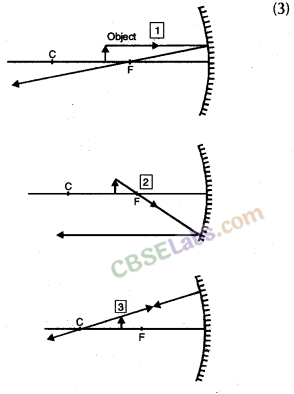
25. For mirrors, the following results hold :
u is – ve, if the object is in front of the mirror.
(Real object)
u is + ve, if the object is behind the mirror.
(Virtual object)
v is – ve, if the image is in front of the mirror.
(Real image)
vis +ve, if the image is behind the mirror.
(Virtual image)
Focal length of a concave mirror is taken as – ve. Focal length of a convex mirror is taken as +ve.
26. When the image formed by a spherical mirror is real, it is also inverted and is on the same side of the mirror as the object. Since both v and u are negative, the magnification is negative.
27. When the image formed by a spherical mirror is virtual, it is also erect and is on the other side of the mirror as the object. In this case, u is – ve and v is + ve , therefore, m is positive.
28. The expression for the mirror formula is 1/u+1/v = 1/f
29. Linear magnification is given by the expression
30. If m is positive, the image is erect w.r.t the object and if m is negative, the image is inverted w.r.t. the object.
31.The position of the image for various positions of the object for a concave mirror is as shown in the table below. The table also shows the use of the mirror for different positions of the object.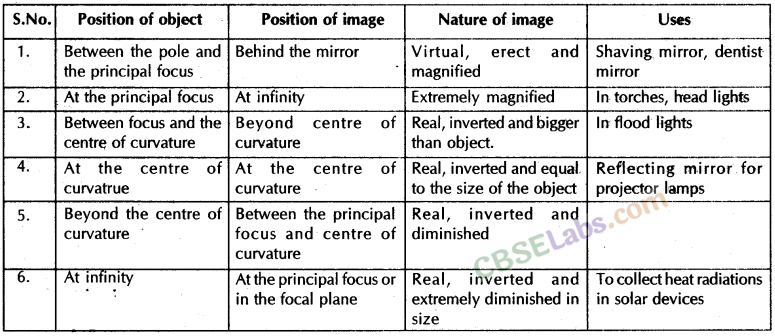
The position of the image for various positions of the object for a convex mirror is as shown in the table below. The table also shows the use of the mirror for different positions of the object.
32. The bending of light when it travels from one medium into another is called refraction of light
33.![]()
34. As light travels from ,one medium to another, the frequency of light does not change.
35. Light refracts because it has different speeds in different media.
36. The refraction of light obeys the following two laws :
- The incident ray, the refracted ray and the normal at the point of incidence all lie in the same plane.
- The ratio of the sine of the angle of incidence to the sine of the angle of refraction is a constant.This
constant is called the index of refraction or refractive index.
37. If wng is the refractive index of glass w.r.t. water, ang be the refractive index of glass w.r.t. air and anw be the refractive index of water w.r.t. air ,then![]()
38. The most familiar and widely used optical device is the lens. A lens is an optical system with two refracting surfaces. The simplest lens has two spherical surfaces close enough together that we can neglect the distance between them. Such a lens is called a thin lens. The two common types of lenses are Converging lens or Convex lens, Diverging lens or Concave lens.
39. It should be noted that, if the above lenses are surrounded by .a material with a refractive index greater than that of the lens, the convex lens gets converted into a concave lens and vice-versa.
40. Any lens that is thicker at its centre than at its edges is a converging lens with positive f, and any lens that is thicker at its edges than at the centre is a diverging lens with negative f.
41. Optical centre : The central point C in the lens is called the optical centre. If a ray is incident towards the optical centre, it passes undeviated .through the lens.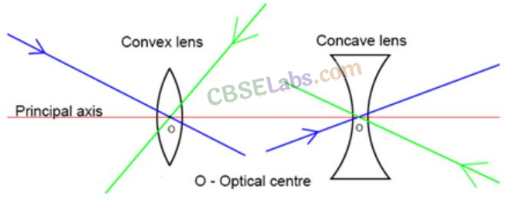
42.Principal axis: Since the lens contains two spherical surfaces, therefore, it has two centres of curvatures.
The line joining these centres and passing through the optical centre is called principal axis.
43. Aperture: The effective width of a lens through which refraction takes place is called the aperture.
44. Focus and Focal Length : If a beam of light moving parallel to the principal axis of a convex lens is incident on it, the rays converge or meet at a point on the principal axis. This point F is called the focus. The distance CF is called the focal length. If a beam of light moving parallel to the principal axis is incident on a concave lens, the beam of light diverges. If these diverged rays are produced backward, they meet at a point F on the principal . axis. The transmitted rays appear to come from this point. This point F is called the focus and distance CF is called the focal length.
45. For drawing the ray diagrams, we note the following :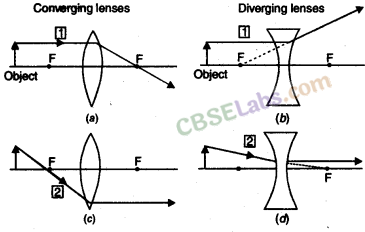
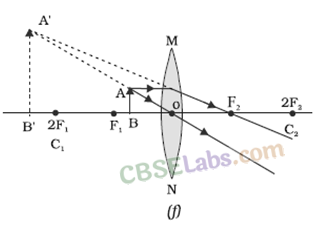
- All rays parallel to the principal axis after refraction pass through the principal focus or seem to come from it.
- A ray of light passing through the focus after refraction becomes parallel to the principal axis.
- A ray of light passing through the optical centre of the lens after refraction passes undeviated.
46. A convex and a concave lens can be supposed to be made-up of prisms.
47. Image formation by a concave lens.
48. Image formation by a convex lens.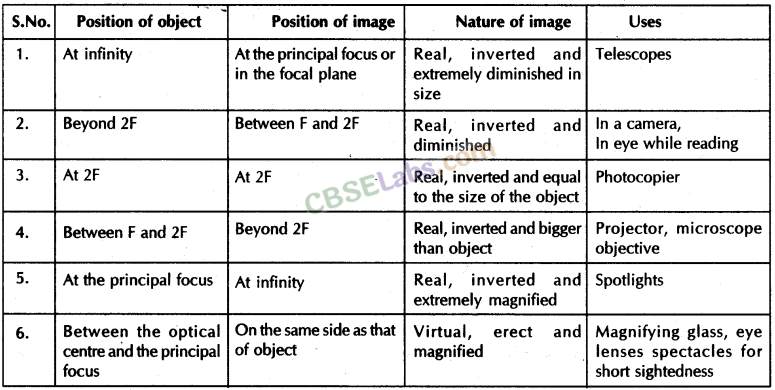
49. New Cartesian sign conventions :
- All distances, object distance (u), image distance (v) and focal length f are measured from the optical centre.
- The distances measured in the direction of incident ray are taken as positive and distances measured against the direction of incident ray are taken as negative.
- All distances (heights) of objects and images above principal axis are taken as positive and those below the principal axis are taken as negative.
50. For the two lenses, the sign conventions take the form
- u is- ve, if the object is in front of the lens. (Real object)
- u is +ve, if the object is virtual.
- v is – ve, if the image is on the same side as that of the object. (Virtual image )
- v is +ve, if the image is real.
- Focal length of a concave lens is taken as – ve.
- Focal length of a convex lens is taken as +ve.
51. Lens formula for convex lens 1/v-1/u = 1/f
52. The linear magnification produced by a lens is defined as the ratio of the size of the image (h’) to the size of the object (h). It is represented by m i.e.,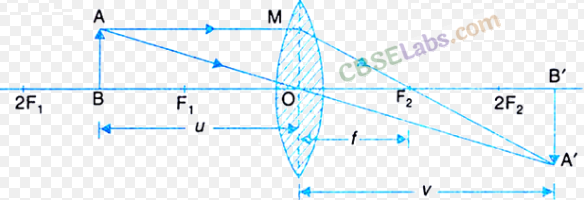
53. If the magnification of a lens is negative, then the image formed is inverted and real.
54. If the magnification of a lens is positive, then the image formed is erect and virtual.
55. Power is defined as the reciprocal of the focal length. Power is measured in dioptre.
Light Reflection and Refraction - NCERT Solutions for Class 10
1. Define the principal focus of a concave mirror.
Answer
Light rays that are parallel to the principal axis of a concave mirror converge at a specific point on its principal axis after reflecting from the mirror. This point is known as the principal focus of the concave mirror.
2. The radius of curvature of a spherical mirror is 20 cm. What is its focal length?
Answer
Radius of curvature, R= 20 cm
Radius of curvature of a spherical mirror = 2 × Focal length (f)R= 2f
f= R/2 = 20 / 2 = 10
Hence, the focal length of the given spherical mirror is 10 cm.
3. Name the mirror that can give an erect and enlarged image of an object.
► Concave Mirror.
4. Why do we prefer a convex mirror as a rear-view mirror in vehicles?
Answer
We prefer a convex mirror as a rear-view mirror in vehicles because it gives a wider field of view, which allows the driver to see most of the traffic behind him. Convex mirrors always form a virtual, erect, and diminished image of the objects placed in front of it.
1. Find the focal length of a convex mirror whose radius of curvature is 32 cm.
Answer
Radius of curvature, R= 32 cm
Radius of curvature = 2 × Focal length (f)
R= 2ff= R/2 = 32/2 = 16
Hence, the focal length of the given convex mirror is 16 cm.
2. A concave mirror produces three times magnified (enlarged) real image of object placed at 10 cm in front of it. Where is the image located?
Answer
Magnification produced by a spherical mirror is given by the relation,
 Object distance, u= - 10 cm
Object distance, u= - 10 cm
v = 3 × ( - 10) = - 30 cm
Here, the negative sign indicates that an inverted image is formed at a distance of
30 cm in front of the given concave mirror.
1. A ray of light travelling in air enters obliquely into water. Does the light ray bend towards the normal or away from the normal? Why?
Answer
The ray of light bends towards the normal. When a ray of light enters from an optically rarer medium (having low refractive index) to an optically denser medium (having high refractive index), its speed slows down and it bends towards the normal. Since water is optically denser than air, a ray of light entering from air into water will bend towards the normal.
2. Light enters from air to glass having refractive index 1.50. What is the speed of light in the glass? The speed of light in vacuum is 3 x 108 ms-1.
Answer
Refractive index of a medium, nm = Speed of light in vacuum/Speed of light in the medium
Speed of light in vacuum, c = 3 × 108 ms-1
Refractive index of glass, ng = 1.50
Speed of light in the glass, v = Speed of light in vacuum/ Refractive index of glass
= c/ng
=3 × 108/1.50 = 2x 108 ms-1.

Answer
Highest optical density = Diamond
Lowest optical density = Air
Optical density of a medium is directly related with the refractive index of that medium. A medium which has the highest refractive index will have the highest optical density and vice-versa.
It can be observed from table 10.3 that diamond and air respectively have the highest and lowest refractive index. Therefore, diamond has the highest optical density and air has the lowest optical
density.
4. You are given kerosene, turpentine and water. In which of these does the light travel fastest? Use the information given in Table.
Material
medium Refractive index Material medium Refractiveindex Air 1.0003 Canada Balsam 1.53 Ice 1.31 - - Water 1.33 Rock salt 1.54 Alcohol 1.36 - - Kerosene 1.44 Carbon disulphide 1.63 Fused
quartz 1.46 Dense
flint glass 1.65 Turpentine oil 1.47 Ruby 1.71 Benzene 1.50 Sapphire 1.77 Crown
glass 1.52 Diamond 2.42
Answer
In water light travel faster as compare to kerosene and turpentine because the refractive index of water is lower than that of kerosene and turpentine. The speed of light is inversely proportional to the refractive index.
5. The refractive index of diamond is 2.42. What is the meaning of this statement?
Answer
The refractive index of diamond is 2.42. This means that the speed of light in diamond will reduce by a factor of 2.42 as compared to its speed in air.
In other words, the speed of light in diamond is 1/2.42 times the speed of light in vacuum.
1. Define 1 dioptre of power of a lens.
Answer
The SI unit of power of lens is dioptre which is denoted by the letter D. 1 dioptre is defined as the power of a lens of focal length 1 metre.
2. A convex lens forms a real and inverted image of a needle at a distance of 50 cm from it. Where is the needle placed in front of the convex lens if the image is equal to the size of the object? Also, find the power of the lens.
Answer
Since the image is real and same size. The position of image should be at 2F.
It is given that the image of the needle is formed at a distance of 50 cm from the convex lens. Hence, the needle is placed in front of the lens at a distance of 50 cm.
Object distance, u= - 50 cm
Image distance, v= 50 cm
Focal length = f
According to the lens formula,

3. Find the power of a concave lens of focal length 2 m.
Answer
Focal length of concave lens, f = 2 mPower of lens, P= 1/f = 1/(-2)= -0.5D
Exercise
1. Which one of the following materials cannot be used to make a lens?
(a) Water
(b) Glass
(c) Plastic
(d) Clay
► (d) Clay
2. The image formed by a concave mirror is observed to be virtual, erect and larger than the object. Where should be the position of the object?
(a) Between the principal focus and the centre of curvature
(b) At the centre of curvature
(c) Beyond the centre of curvature
(d) Between the pole of the mirror and its principal focus.
► (d) Between the pole of the mirror and its principal focus.
3. Where should an object be placed in front of a convex lens to get a real image of the size of the object?
(a) At the principal focus of the lens
(b) At twice the focal length
(c) At infinity
► (b) At twice the focal length
4. A spherical mirror and a thin spherical lens have each a focal length of -15 cm. The mirror and the lens are likely to be
(a) both concave
(b) both convex
(c) the mirror is concave and the lens is convex
(d) the mirror is convex, but the lens is concave
► (a) both concave
5. No matter how far you stand from a mirror, your image appears erect. The mirror is likely to be
(a) plane
(b) concave
(c) convex
(d) either plane or convex
► (d) either plane or convex
6. Which of the following lenses would you prefer to use while reading small letters found in a dictionary?
(a) A convex lens of focal length 50 cm
(b) A concave lens of focal length 50 cm
(c) A convex lens of focal length 5 cm
(d) A concave lens of focal length 5 cm
► (c) A convex lens of focal length 5 cm
7. We wish to obtain an erect image of an object, using a concave mirror of focal length 15 cm. What should be the range of distance of the object from the mirror? What is the nature of the image? Is the image larger or smaller than the object? Draw a ray diagram to show the image formation in this case.
Answer
Range of the distance of the object = 0 to 15 cm from the pole of the mirror.
Nature of the image = virtual, erect and larger than the object.

8. Name the type of mirror used in the following situations.
(a) Headlights of a car
(b) Side/rear-view mirror of a vehicle
(c) Solar furnace
Support your answer with reason.
Answer
(a) Concave Mirror: This is because concave mirrors can produce powerful parallel beam of light when the light source is placed at their principal focus.
(b) Convex Mirror: This is because of its largest field of view.
(c) Concave Mirror: This is because it concentrates the parallel rays of sun at principal focus.
9. One-half of a convex lens is covered with a black paper. Will this lens produce a complete image of the object? Verify your answer experimentally. Explain your observations.
Answer
The convex lens will form complete image of an object, even if its one half is covered with black paper. It can be understood by the following two cases.
Case I
 When the upper half of the lens is covered
When the upper half of the lens is covered
In this case, a ray of light coming from the object will be refracted by the lower half of the lens. These rays meet at the other side of the lens to form the image of the given object, as shown in the above figure.
Case II When the lower half of the lens is covered
When the lower half of the lens is covered
In this case, a ray of light coming from the object is refracted by the upper half of the lens. These rays meet at the other side of the lens to form the image of the given object, as shown in the above figure.
10. An object 5 cm in length is held 25 cm away from a converging lens of focal length 10 cm. Draw the ray diagram and find the position, size and the nature of the image formed.
Answer


11. A concave lens of focal length 15 cm forms an image 10 cm from the lens. How far is the object placed from the lens? Draw the ray diagram.
Answer
Focal length of concave lens (OF1), f = - 15 cmImage distance, v= - 10 cm
According to the lens formula,

The negative value of u indicates that the object is placed 30 cm in front of the lens. This is shown in the following ray diagram.

12. An object is placed at a distance of 10 cm from a convex mirror of focal length 15 cm. Find the position and nature of the image.
Answer
Focal length of convex mirror, f= +15 cm
Object distance, u= - 10 cm
According to the mirror formula,
 The image is located at a distance 6 cm from the mirror on the other side of the mirror.The positive and value less than 1 of magnification indicates that the image formed is virtual and erect and diminished.
The image is located at a distance 6 cm from the mirror on the other side of the mirror.The positive and value less than 1 of magnification indicates that the image formed is virtual and erect and diminished.
13. The magnification produced by a plane mirror is +1. What does this mean?
Answer
The positive sign means image formed by a plane mirror is virtual and erect. Since the magnification is 1 it means that the size of the image is equal to the size of the object.
14. An object 5 cm is placed at a distance of 20 cm in front of a convex mirror of radius of curvature 30 cm. Find the position, nature and size of the image.
Answer
Object distance, u= - 20 cm
Object height, h= 5 cm
Radius of curvature, R= 30 cm
Radius of curvature = 2 × Focal length
R= 2f
f= 15 cm
According to the mirror formula,
 The positive value of image height indicates that the image formed is erect.
The positive value of image height indicates that the image formed is erect.
Therefore, the image formed is virtual, erect, and smaller in size.
15. An object of size 7.0 cm is placed at 27 cm in front of a concave mirror of focal length 18 cm. At what distance from the mirror should a screen be placed, so that a sharp focused image can be obtained? Find the size and the nature of the image.
Answer
Object distance, u= - 27 cm
Object height, h= 7 cm
Focal length, f = - 18 cm
According to the mirror formula,
 The negative value of image height indicates that the image formed is inverted.
The negative value of image height indicates that the image formed is inverted.
16. Find the focal length of a lens of power -2.0 D. What type of lens is this?
Answer
Power of lens, P= 1/f
P= -2D
f= -1/2 = -0.5 m
A concave lens has a negative focal length. Hence, it is a concave lens.
17. A doctor has prescribed a corrective lens of power +1.5 D. Find the focal length of the lens. Is the prescribed lens diverging or converging?
Answer
Power of lens, P= 1/f
P= 1.5D
f= 1/1.5 = 10/15 = 0.66 m
A convex lens has a positive focal length. Hence, it is a convex lens or a converging lens.
Answer
Light rays that are parallel to the principal axis of a concave mirror converge at a specific point on its principal axis after reflecting from the mirror. This point is known as the principal focus of the concave mirror.
2. The radius of curvature of a spherical mirror is 20 cm. What is its focal length?
Answer
Radius of curvature, R= 20 cm
Radius of curvature of a spherical mirror = 2 × Focal length (f)R= 2f
f= R/2 = 20 / 2 = 10
Hence, the focal length of the given spherical mirror is 10 cm.
3. Name the mirror that can give an erect and enlarged image of an object.
► Concave Mirror.
4. Why do we prefer a convex mirror as a rear-view mirror in vehicles?
Answer
We prefer a convex mirror as a rear-view mirror in vehicles because it gives a wider field of view, which allows the driver to see most of the traffic behind him. Convex mirrors always form a virtual, erect, and diminished image of the objects placed in front of it.
1. Find the focal length of a convex mirror whose radius of curvature is 32 cm.
Answer
Radius of curvature, R= 32 cm
Radius of curvature = 2 × Focal length (f)
R= 2ff= R/2 = 32/2 = 16
Hence, the focal length of the given convex mirror is 16 cm.
2. A concave mirror produces three times magnified (enlarged) real image of object placed at 10 cm in front of it. Where is the image located?
Answer
Magnification produced by a spherical mirror is given by the relation,

v = 3 × ( - 10) = - 30 cm
Here, the negative sign indicates that an inverted image is formed at a distance of
30 cm in front of the given concave mirror.
1. A ray of light travelling in air enters obliquely into water. Does the light ray bend towards the normal or away from the normal? Why?
Answer
The ray of light bends towards the normal. When a ray of light enters from an optically rarer medium (having low refractive index) to an optically denser medium (having high refractive index), its speed slows down and it bends towards the normal. Since water is optically denser than air, a ray of light entering from air into water will bend towards the normal.
2. Light enters from air to glass having refractive index 1.50. What is the speed of light in the glass? The speed of light in vacuum is 3 x 108 ms-1.
Answer
Refractive index of a medium, nm = Speed of light in vacuum/Speed of light in the medium
Speed of light in vacuum, c = 3 × 108 ms-1
Refractive index of glass, ng = 1.50
Speed of light in the glass, v = Speed of light in vacuum/ Refractive index of glass
= c/ng
=3 × 108/1.50 = 2x 108 ms-1.

Answer
Highest optical density = Diamond
Lowest optical density = Air
Optical density of a medium is directly related with the refractive index of that medium. A medium which has the highest refractive index will have the highest optical density and vice-versa.
It can be observed from table 10.3 that diamond and air respectively have the highest and lowest refractive index. Therefore, diamond has the highest optical density and air has the lowest optical
density.
4. You are given kerosene, turpentine and water. In which of these does the light travel fastest? Use the information given in Table.
| Material medium | Refractive index | Material medium | Refractive index |
| Air | 1.0003 | Canada Balsam | 1.53 |
| Ice | 1.31 | - | - |
| Water | 1.33 | Rock salt | 1.54 |
| Alcohol | 1.36 | - | - |
| Kerosene | 1.44 | Carbon disulphide | 1.63 |
| Fused quartz | 1.46 | Dense flint glass | 1.65 |
| Turpentine oil | 1.47 | Ruby | 1.71 |
| Benzene | 1.50 | Sapphire | 1.77 |
| Crown glass | 1.52 | Diamond | 2.42 |
Answer
In water light travel faster as compare to kerosene and turpentine because the refractive index of water is lower than that of kerosene and turpentine. The speed of light is inversely proportional to the refractive index.
5. The refractive index of diamond is 2.42. What is the meaning of this statement?
Answer
The refractive index of diamond is 2.42. This means that the speed of light in diamond will reduce by a factor of 2.42 as compared to its speed in air.
In other words, the speed of light in diamond is 1/2.42 times the speed of light in vacuum.
1. Define 1 dioptre of power of a lens.
Answer
The SI unit of power of lens is dioptre which is denoted by the letter D. 1 dioptre is defined as the power of a lens of focal length 1 metre.
2. A convex lens forms a real and inverted image of a needle at a distance of 50 cm from it. Where is the needle placed in front of the convex lens if the image is equal to the size of the object? Also, find the power of the lens.
Answer
Since the image is real and same size. The position of image should be at 2F.
Object distance, u= - 50 cm
Image distance, v= 50 cm
Focal length = f
According to the lens formula,

Answer
Focal length of concave lens, f = 2 mPower of lens, P= 1/f = 1/(-2)= -0.5D
Exercise
1. Which one of the following materials cannot be used to make a lens?
(a) Water
(b) Glass
(c) Plastic
(d) Clay
► (d) Clay
2. The image formed by a concave mirror is observed to be virtual, erect and larger than the object. Where should be the position of the object?
(a) Between the principal focus and the centre of curvature
(b) At the centre of curvature
(c) Beyond the centre of curvature
(d) Between the pole of the mirror and its principal focus.
► (d) Between the pole of the mirror and its principal focus.
3. Where should an object be placed in front of a convex lens to get a real image of the size of the object?
(a) At the principal focus of the lens
(b) At twice the focal length
(c) At infinity
► (b) At twice the focal length
4. A spherical mirror and a thin spherical lens have each a focal length of -15 cm. The mirror and the lens are likely to be
(a) both concave
(b) both convex
(c) the mirror is concave and the lens is convex
(d) the mirror is convex, but the lens is concave
► (a) both concave
5. No matter how far you stand from a mirror, your image appears erect. The mirror is likely to be
(a) plane
(b) concave
(c) convex
(d) either plane or convex
► (d) either plane or convex
6. Which of the following lenses would you prefer to use while reading small letters found in a dictionary?
(a) A convex lens of focal length 50 cm
(b) A concave lens of focal length 50 cm
(c) A convex lens of focal length 5 cm
(d) A concave lens of focal length 5 cm
► (c) A convex lens of focal length 5 cm
7. We wish to obtain an erect image of an object, using a concave mirror of focal length 15 cm. What should be the range of distance of the object from the mirror? What is the nature of the image? Is the image larger or smaller than the object? Draw a ray diagram to show the image formation in this case.
Answer
Range of the distance of the object = 0 to 15 cm from the pole of the mirror.
Nature of the image = virtual, erect and larger than the object.

(a) Headlights of a car
(b) Side/rear-view mirror of a vehicle
(c) Solar furnace
Support your answer with reason.
Answer
The convex lens will form complete image of an object, even if its one half is covered with black paper. It can be understood by the following two cases.
Case I

In this case, a ray of light coming from the object will be refracted by the lower half of the lens. These rays meet at the other side of the lens to form the image of the given object, as shown in the above figure.

In this case, a ray of light coming from the object is refracted by the upper half of the lens. These rays meet at the other side of the lens to form the image of the given object, as shown in the above figure.
Answer


According to the lens formula,


Object distance, u= - 10 cm
According to the mirror formula,

13. The magnification produced by a plane mirror is +1. What does this mean?
Answer
The positive sign means image formed by a plane mirror is virtual and erect. Since the magnification is 1 it means that the size of the image is equal to the size of the object.
14. An object 5 cm is placed at a distance of 20 cm in front of a convex mirror of radius of curvature 30 cm. Find the position, nature and size of the image.
Answer
Object distance, u= - 20 cm
Object height, h= 5 cm
Radius of curvature, R= 30 cm
Radius of curvature = 2 × Focal length
R= 2f
f= 15 cm
According to the mirror formula,

Therefore, the image formed is virtual, erect, and smaller in size.
15. An object of size 7.0 cm is placed at 27 cm in front of a concave mirror of focal length 18 cm. At what distance from the mirror should a screen be placed, so that a sharp focused image can be obtained? Find the size and the nature of the image.
Answer
Object distance, u= - 27 cm
Object height, h= 7 cm
Focal length, f = - 18 cm
According to the mirror formula,

16. Find the focal length of a lens of power -2.0 D. What type of lens is this?
Answer
Power of lens, P= 1/f
P= -2D
f= -1/2 = -0.5 m
A concave lens has a negative focal length. Hence, it is a concave lens.
17. A doctor has prescribed a corrective lens of power +1.5 D. Find the focal length of the lens. Is the prescribed lens diverging or converging?
Answer
Power of lens, P= 1/f
P= 1.5D
f= 1/1.5 = 10/15 = 0.66 m
A convex lens has a positive focal length. Hence, it is a convex lens or a converging lens.



